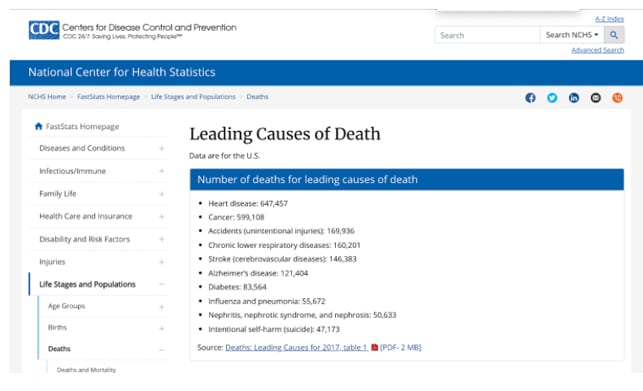

Heart Disease, cancer, and the medical system, in that order, are the top three causes of death in the US.[2] Yes, you read that right.
According to an article published in 2000, 106,000 people are killed annually by the side effects of correctly administered prescription drugs.[2] Add the deaths caused by unnecessary surgeries, hospital-caused infections, and medical errors including incorrect use of prescription medications, botched surgeries, and mistakes related to machine monitoring and programming, and the death toll jumps to at least 215,000.[2]

The scariest part? In the 20 years since, studies suggest these numbers have only gone up. Some analyses suggest that the annual death count may be as high as 400,000![1][6] Yikes!
And if that isn’t spooky enough, check out the CDC web page on the leading causes of death in the United States:

Notice anything? That’s right—deaths caused by the medical system are entirely hidden.[11]
Despite paying more per capita on “health” than every other country, the quality of our healthcare continues to rank near the bottom when compared to other industrialized nations.[2] This discrepancy between cost and care is especially relevant now. Decades of rising healthcare costs are now coinciding with a rise in the number of people who have lost their employer-provided health insurance during the COVID-19 pandemic.[9][12] Even before the pandemic, medical bills were the #1 cause of bankruptcy in the US. A 2007 study found that medical bills resulted in 62.1% of all bankruptcies.[7] And in the past year alone, medical debt increased 7%, with a 3% rise since the beginning of the pandemic.[12]

Think our “healthcare” system is invested in making us healthier? Think again.
The proof is in the hospital-provided pudding—literally. Despite a massive body of evidence indicating that whole food, plant-based (WFPB) diets can prevent and treat killers like heart disease, cancer, and diabetes, the medical system largely ignores dietary intervention as an effective method of primary prevention and treatment. Instead, the system encourages invasive treatments and therapies with far more dangerous track records and associated risks:[3] prescription medications, surgeries, and invasive therapies.
What do these preferred “treatments” have in common? For one thing, they can be bought and sold, unlike plant-based diets. Because plant-based diets and lifestyle changes don’t put money into the pockets of pharmaceutical and insurance companies, they are preferentially disregarded as legitimate forms of treatment.[3]

As Dr. T. Colin Campbell puts it in his book Whole (2013), “if the [whole foods plant-based] diet were a pill, its inventor would be the wealthiest person on earth.”[3] Since it’s effects cannot be contained to a pill that can be sold at marked up prices and covered by insurance, powerful interests have organized to ignore, discredit, and hide the truth for the sake of profit.[3]
To put it simply, you are worth more to our healthcare system sick than healthy. As a result, there is a built-in incentive for the medical system to promote bad health. Sick, isn’t it?
At this point you might be thinking that everyone involved in the medical system is an income-sucking vampire that feasts on our misery and life-savings. But the true reason for doctors’ complicity in this system is even more terrifying: they simply don’t know any better.
Despite the fact that the benefits of plant-based diets have been known and recorded as far back as Hippocrates, our modern, for-profit disease-care system has made a concerted effort to eliminate this knowledge from our collective consciousness.[5] Discrediting nutrition as a necessary component of medicine is a major part of that effort. Today, doctors are not even required to receive the minimum 25 hours of training in nutrition recommended by the Liaison Committee on Medical Education, the accreditation organization for U.S. medical schools.[10] Only 27% of medical schools offer the recommended amount of training, with the average amount offered totaling 19.6 hours.[4][8]

If anything, medical schools smear nutrition. Surveys given to medical students before and after graduation indicate that medical schools encourage the notion that nutrition lacks importance in the practice of medicine.[4] Entering medical school, 71% of students believe that nutrition is clinically important; by graduation, this number drops below 50%.[4] In addition, less than 14% of practicing physicians surveyed believe they were “adequately trained in nutritional counseling.”[4]
The purpose of this scary story is not to spook you out of a trip to the doctor’s. On the contrary, I want to stress that trust in evidence-based science and medicine, including nutrition, is highly important for our personal and public health. Overall, we have made huge strides in providing life-saving care for so many health problems. Today, the fate of our world rests on the availability of biotechnologies like vaccines and ventilators as well as the essential work of doctors, nurses, paramedics, hospital staff, and all others on the frontlines of the pandemic. The truth is, the miracles of modern medicine are many.
Still, the medical system has a long way to go before it can be called “health care” in earnest.
Copyright 2025 Center for Nutrition Studies. All rights reserved.